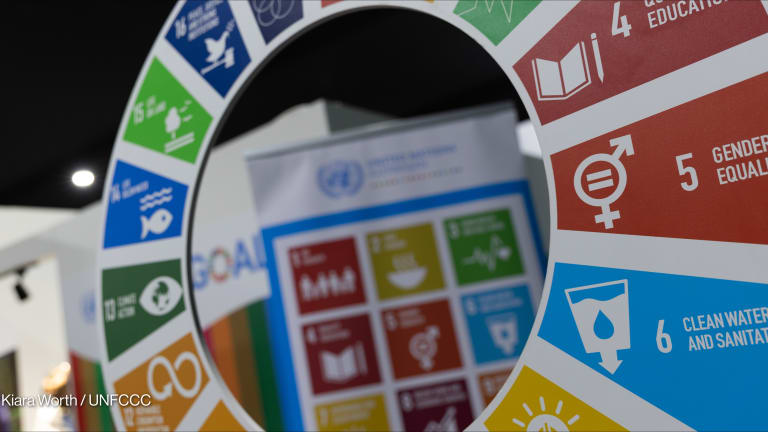
SAN FRANCISCO — Prior to its relaunch, nonprofit organization Cadasta had become so focused on the technology side of its work that it distracted from the needs of partners in the field.
“When you’re building out a new platform, it really is all consuming,” said Cadasta CEO Amy Coughenour, reflecting on some of the decisions that were made prior to her joining the team in 2018.
Launched in January 2015, Cadasta was initially built on an open-source platform to help partners document, analyze, store, and share information on land rights.
Conference Call: Should NGOs embrace open source technology?
Devex Senior Reporter Catherine Cheney is joined by experts from Omidyar Network and the Radiant Earth Foundation to discuss the benefits, drawbacks, and other key considerations for ICT4D practitioners and innovators.
But for a number of reasons, that model was not working. Partners were soon asking for new features, and the requests were piling up. Cadasta put a lot of time and money into the product, but it was not always meeting the needs of their partners, Coughenour said. And some of the problems the organization ran into had already been solved by technology companies that build mapping software for mobile data collection.
“You could have the most beautiful tech stack in the world, but if you’re not having partners use it, you’re going to be in trouble,” Coughenour said. “Over time, as the product continued to be unsatisfactory according to what the donors were looking for and the partners needed, I think it got to the point of: ‘This is not sustainable.’”
In March 2019, Cadasta launched a new mobile tech platform powered by Esri, a mapping software company that offers commercial geographic information systems, or GIS, software with preferential pricing for nonprofits.
“Technology choices should never be driven by ideology. They should be driven by meeting the needs. They should be driven by being responsive and able to deliver what needs to get done.”
— Amy Coughenour, CEO, CadastaDue in part to the influence of the Principles for Digital Development, released in 2015, open-source software has become the default choice for many nonprofits working on digital development interventions.
Open source refers to software with source code available for anyone to access and modify, and this model tends to resonate with a sector committed to social good, as compared to proprietary software that is solely owned by its developers. But oftentimes nonprofits decide to publish open-source code without thinking through the long-term configuration and maintenance costs tied to it.
Many nonprofits, including Cadasta, face significant development costs to create and support their open-source software that can exceed proprietary license costs. Devex spoke with a range of experts about how nonprofits can be more effective in deciding when it makes sense to build open-source tools.
Building on top of existing products
Many nonprofit leaders opt for open-source software because of the idea that their work should be a public good. While the decision may demonstrate goodwill, it does not always add as much value as they might think, according to several tech for development experts based in Silicon Valley.
What does the World Bank's Silicon Valley strategy look like now?
Its disruptive technology approach was catalyzed in the former president's office, but the World Bank Group's Silicon Valley strategy was never going to vanish with Jim Kim's departure, staff explain to Devex.
If the nonprofit puts an open-source license on the product and uploads the code to GitHub, a tool that helps people build software, the next step is to build a community of users around the product, said Marnie Webb, chief community impact officer at TechSoup, which supports nonprofits with discounts on software, hardware, and services.
This means the nonprofit has to consider a governance structure that extends beyond its own leadership and work with a community of developers to maintain the product and support the users.
“When we look at open-source software and think of success stories like Apache or Open Office, what we really see are users who can also be contributors to the product, whereas that’s not true for most nonprofits,” Webb said.
The challenge nonprofits often run into is that the community of users for open-source products specific to the nonprofit sector is so small that they do not see the benefits of open source.
“Software developers doing coding because it scratches their own itch, companies contributing because it is a product that powers the internet, all of that disappears,” Webb said.
Rather than open sourcing from top to bottom, nonprofit organizations might consider building products that rest on top of commercially available software packages, she added.
Tech Matters is one organization that aims to do that by building open-source platforms for social change organizations on top of a technology stacks from commercial platform providers including Amazon, Twilio, and Microsoft, which offer nonprofit discounts.
The problem with open-source technology in the nonprofit sector has less to do with the license of the software, and more to do with “the cult of the custom,” which leads nonprofits to build their own software versus using existing tools, said Jim Fruchterman, founder and CEO of Tech Matters.
“The reason why I think a lot of open-source projects in the nonprofit world fail is because it was actually a custom project that someone put the open-source label on, but it didn’t have 2,000 users or 20,000 users, it had one user,” he said.
Much of the nonprofit world is stuck in the way “business used to run 30 years ago,” Fruchterman said, where every big company would build their own software, but today there are a huge range of software as a service options available — and often at a discount to nonprofits.
This dynamic is what led the founder of the nonprofit technology company Benetech to launch Tech Matters last year — going beyond what off the shelf providers can offer so that organizations can maintain their focus on making social change versus building software.
Going beyond open source at any cost
The Principles for Digital Development, guidelines backed by donors and implementers, were created to help inform the design of technology-enabled programs.
One of the nine principles is: “Use open standards, open data, open source, and open innovation.”
The principle explains: “To what extent your initiative uses open-source software will depend on the needs identified for your context and an assessment of which of the available options best meets those needs, factoring in their total cost of ownership.”
It links to a guide on how to calculate the total cost of ownership of software. Some questions have to do with whether the licensing model is open source or proprietary, asking, for example: “If the software is open source, is there a responsive, established user community that will provide support and help add features at no cost?” Others have to do with issues like management and staffing, interoperability with other systems, and hardware maintenance, administration, and replacement.
Several experts who spoke with Devex expressed frustration that donors, through these principles and their guidelines for grantmaking, push the sector in the direction of open source at any cost.
Nick Martin, founder and CEO of TechChange, an organization that produces courses on the use of technology for social change, has built proprietary software from the beginning.
He said he thinks the spirit of the principle mentioning open data has more to do with being open as opposed to building open-source code, and said TechChange fits this model in a number of ways.
“Most donors I’ve talked to, for them it’s not necessarily about open source, but open resources, and for us it means open courses,” Martin said. “We blog a lot about our process, what went well and what didn’t, so people don’t make the same mistakes.”
Donors could have less prescriptive guidelines and still accomplish the same goals. For example, instead of expressing a preference for open source, donors could encourage grantees to make the intellectual property or IP around any customizations they do available to other nonprofits, which could then use that code for their own purposes, said Webb of TechSoup. This would still lower the costs of development, allow for the opportunity to work on the product in a community of users, and enable faster change
Peter Rabley, director of investments at Omidyar Network, has made the point to many of the organizations he supports that open source isn’t really free.
“Obviously, technology more and more is in the service of many of the goals of NGOs, but you can’t be distracted and go down that rabbit hole of saying, ‘We can build it, we should build it internally,” he told Devex.
Like Cadasta, Radiant Earth, another Omidyar Network grantee, ran into some unanticipated challenges with open-source technology.
When the organization was founded in 2016, there were no software as a service platforms to access open satellite, drone, and aircraft imagery. Radiant Earth wanted to democratize that data for the global development community and set forth trying to build that product. The organization went through a procurement process and selected an open-source project that was ultimately unsuccessful.
Since then, Radiant Earth has pivoted, and now focuses on helping the global development community apply machine learning to Earth observation.
“We had to take a long hard look at: Is that an appropriate use of philanthropic dollars and is it really getting us to the mission? Do we really want to be building software or helping people use imagery data for global development issues? And we chose the latter,” said Anne Hale Miglarese, founder and CEO of Radiant Earth.
When Cadasta decided to go with Esri, strong advocates of open-source technology left the organization, saying they wanted nothing to do with this new model.
“Technology choices should never be driven by ideology,” Coughenour said. “They should be driven by meeting the needs. They should be driven by being responsive and able to deliver what needs to get done.”








